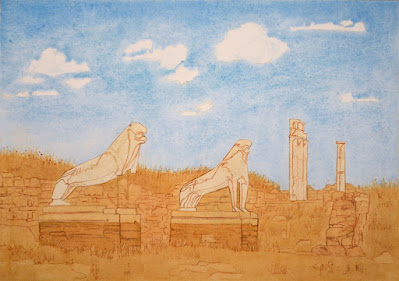watercolour on Arches 36x57cm
One of my better fortunes in life is to have a room with a view. Everyday for decades I watch the lightshow across the water. I have become obsessed with these 2 mountains. The big one is named Klokova. Nobody calls it this. It is better known as "Paliovouna" literally meaning 'Horrible old mountain'. In ancient times it was called "Tafiassos".
According to Greek mythology, this mountain is where the grave of Nessus is located. "Who is Nessus?" you may well ask. Nessus was a centaur. According to the story he abducted Heracle's wife Deianeira and while attempting to cross the Evinos river, Heracles shot a poison arrow into his chest and killed him. The story however does not end there for this is Greek mythology afterall. It is up to you to find out how this ancient melodrama continues.
Since this became a grave site for Nessus and his other centaur friends, it has been said that the waters that flow at its base were poisoned from the decomposition of the centaurs' bodies. The water was described as having a foul stench and containing clots of blood. Rationalists in our time who know how to ruin a good story explain this as a volcanic source that would exude hydrogen sulphide, a particularly foul smelling gas.
Beauty and a dark past come together nicely.
The smaller mountain is Varasova. Unlike it's neighbour, this mountain was a place for Christian ascetics, people who decided to check out of the every day and seek God. It is full of the remains of their monasteries and hermitages that had flourished during the Byzantine empire. There is also an abandoned monastery dedicated to saint Nicholas that can only be accessed by boat. Once a year people congregate there to conduct services. This mountain is a place of great archaeological interest and there have been digs conducted by the University of Ioannina. But it is also a place of botanical interest. The plant native to the mountain and found nowhere else in the world is Centaurea Heldreichii. It is unfortunately listed as critically endangered.
Μία καλή τύχη στη ζωή μου είναι ότι εχω δωμάτιο με θέα. Κάθε μέρα για δεκαετίες παρατηρώ το θέαμα του φωτός απέναντι. Με έχουν συνεπάρει αυτά τα 2 βουνά.
Το μεγάλο λέγεται «Κλόκοβα» άλλα είναι κοινώς γνωστό ως «Παλιοβούνα». Στην αρχαιότητα ονομαζόταν «Ταφιασσός». Στη μυθολογία είναι η τοποθεσία που ενταφιάστηκε ο Νέσσος. Και ποιός είναι αυτός; θα ρωτούσε κανείς. Ο Νέσσος ήταν κένταυρος. Η ιστορία λέει ότι άρπαξε την γυναίκα του Ηρακλή την Δηϊάνειρα και λίγο πριν καταφέρει να περάσει τον ποταμό Ευήνου, έριξε ο Ηρακλής ένα δηλτηριασμένο βελός που τον χτύπησε στο στήθος και τον σκότωσε. Η ιστορία όμως έχει και συνέχεια αλλά την αφήνω σε σας να την ανακαλύψτε.
Επειδή το βουνό έγινε ο τάφος του Νέσσου και τον άλλων κενταύρων, έχει ειπωθεί ότι τα νερά που πηγάζουν στη βάση του είναι «…δυσώδες και με θρόμβους από αίμα…». Δηλτηριασμένα από την αποσύνθεση των σωμάτων τους. Οι ορθολογιστές της εποχής μας που έχουν μια τάση να καταστρέφουν μια καλή ιστορία εξηγούν ότι κατά πάσα πιθανότητα επρόκειτο για κάποια ηφαιστειακή πηγή που συνοδευόταν από έκλυση του εξαιρετικά δύσοσμου αερίου υδροθείου.
Το μικρότερο βουνό είναι η «Βαράσοβα». Σε αντίθεση με τον γείτονά του, αυτό το βουνό ήταν μια τοποθεσία για ασκητές. Είναι γεμάτο από ερείπια μοναστηριών και ασκηταριών που ανθούσαν την εποχή του Βυζαντίου. Υπάρχει και το μοναστήρι του Αγίου Νικολάου που η κτίση του ανάγεται από τον 10ο αιώνα. Βρίσκεται σε ένα σπήλαιο στην νότια πλευρά του βουνού και πρόσβαση σε αυτό γίνεται δια θαλάσσης. Μία φορά τον χρόνο πιστοί τελούν εκεί τη Θεία λειτουργία.
Υπάρχει όμως και ενδιαφέρον για τους βοτανολόγους. Η Βαράσοβα είναι το μοναδικό μέρος στη γη όπου βρίσκεται το φυτό Centaura Heldreichii, το οποίο δυστυχώς θεωρείται κρισίμως απειλούμενο.















